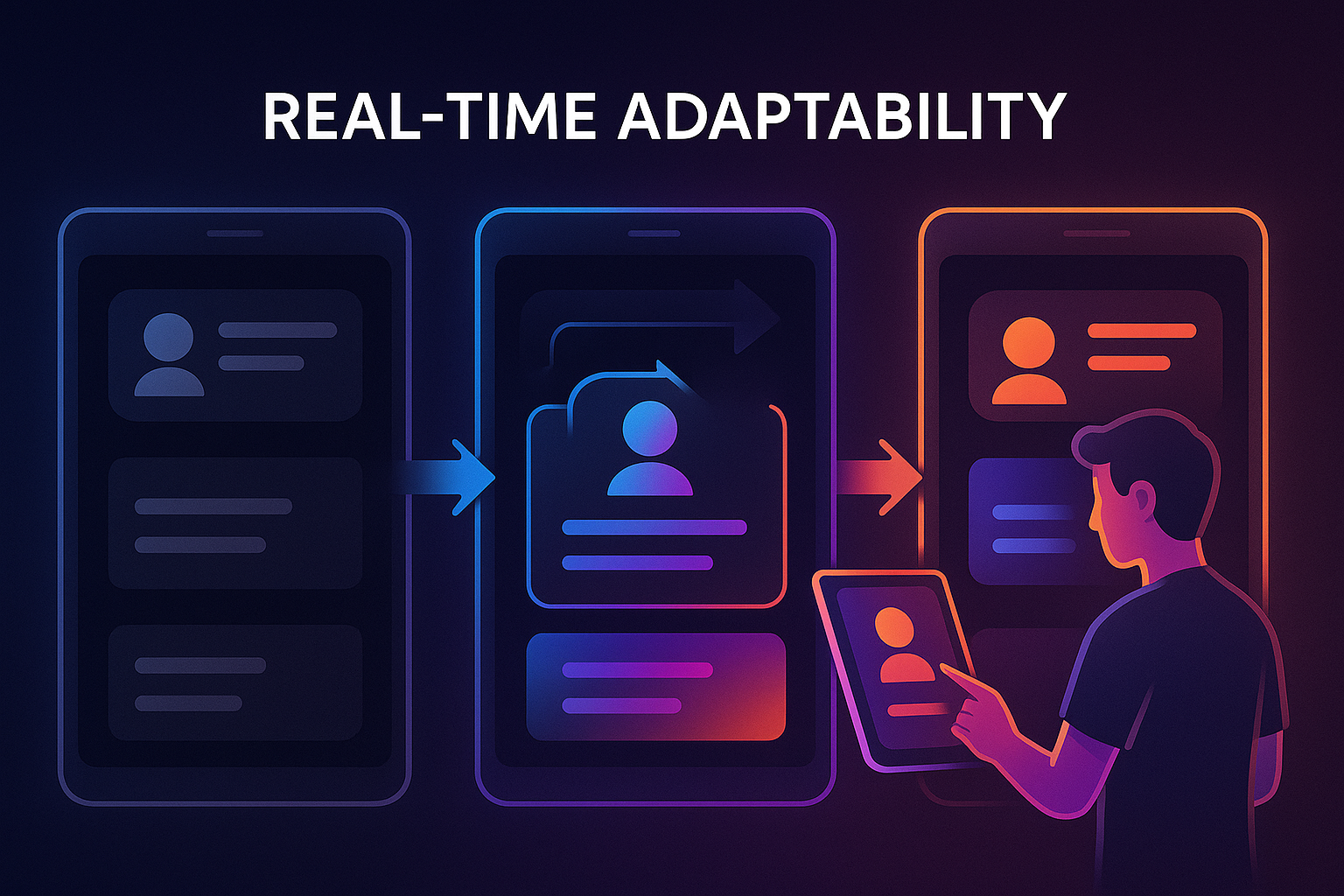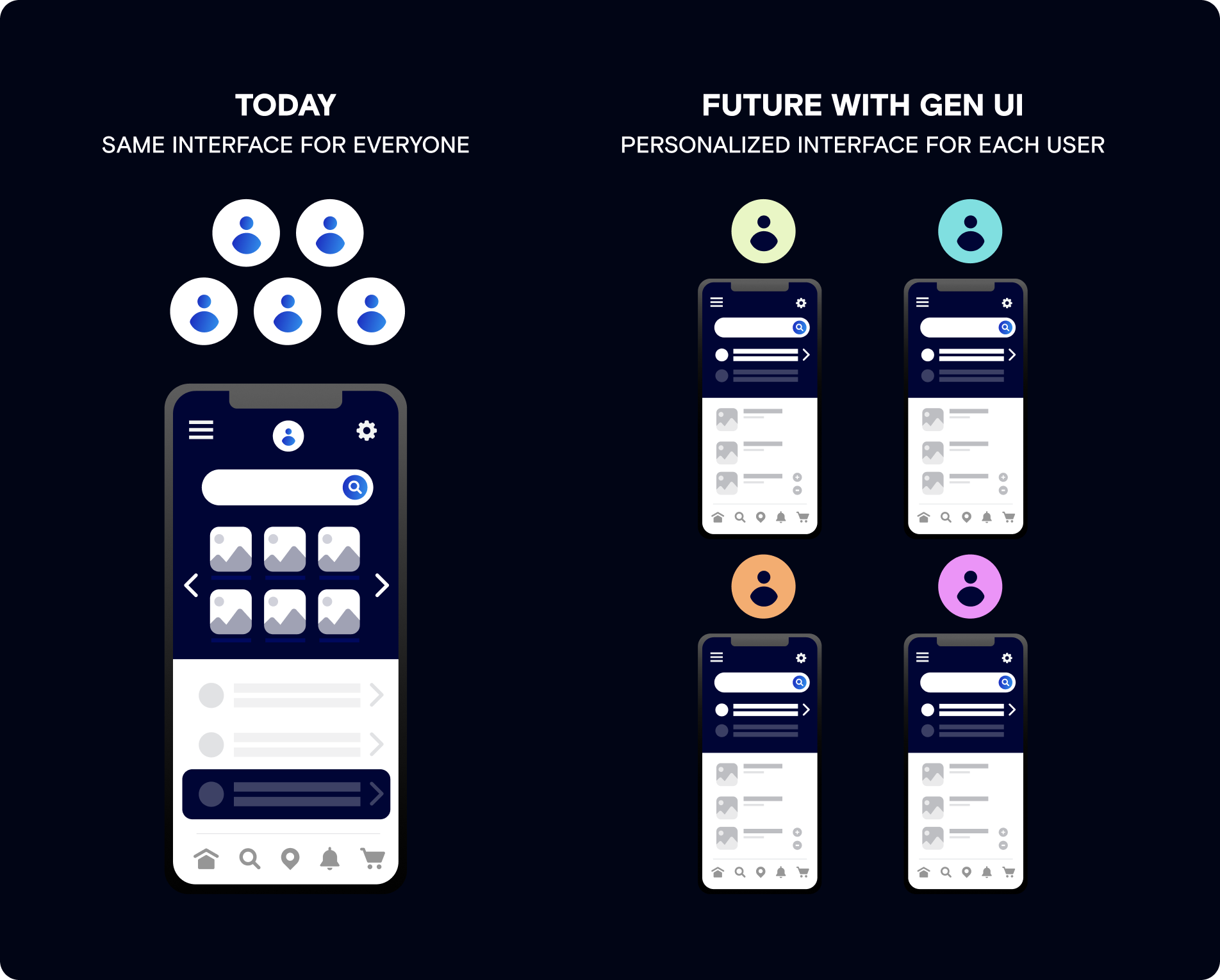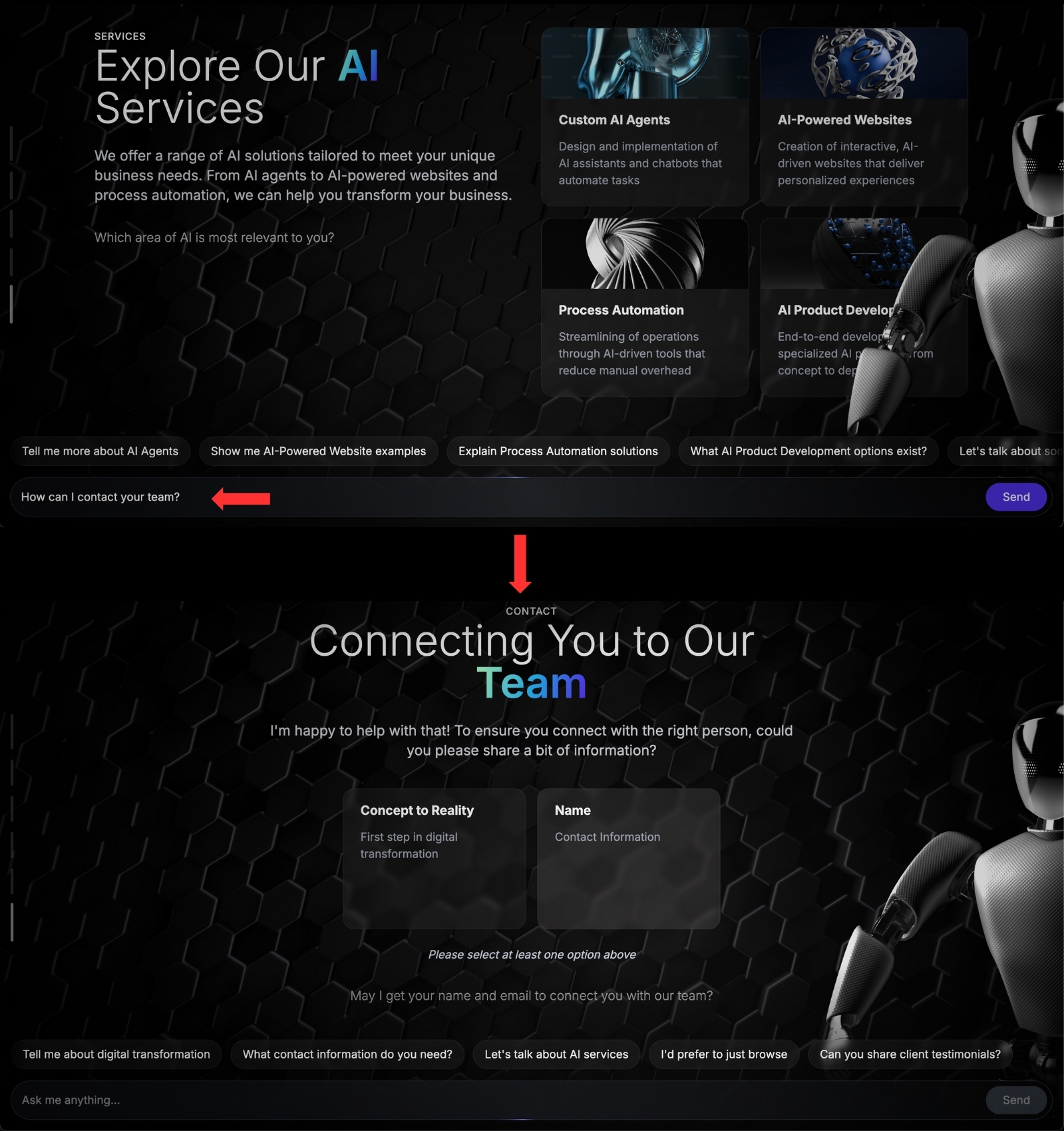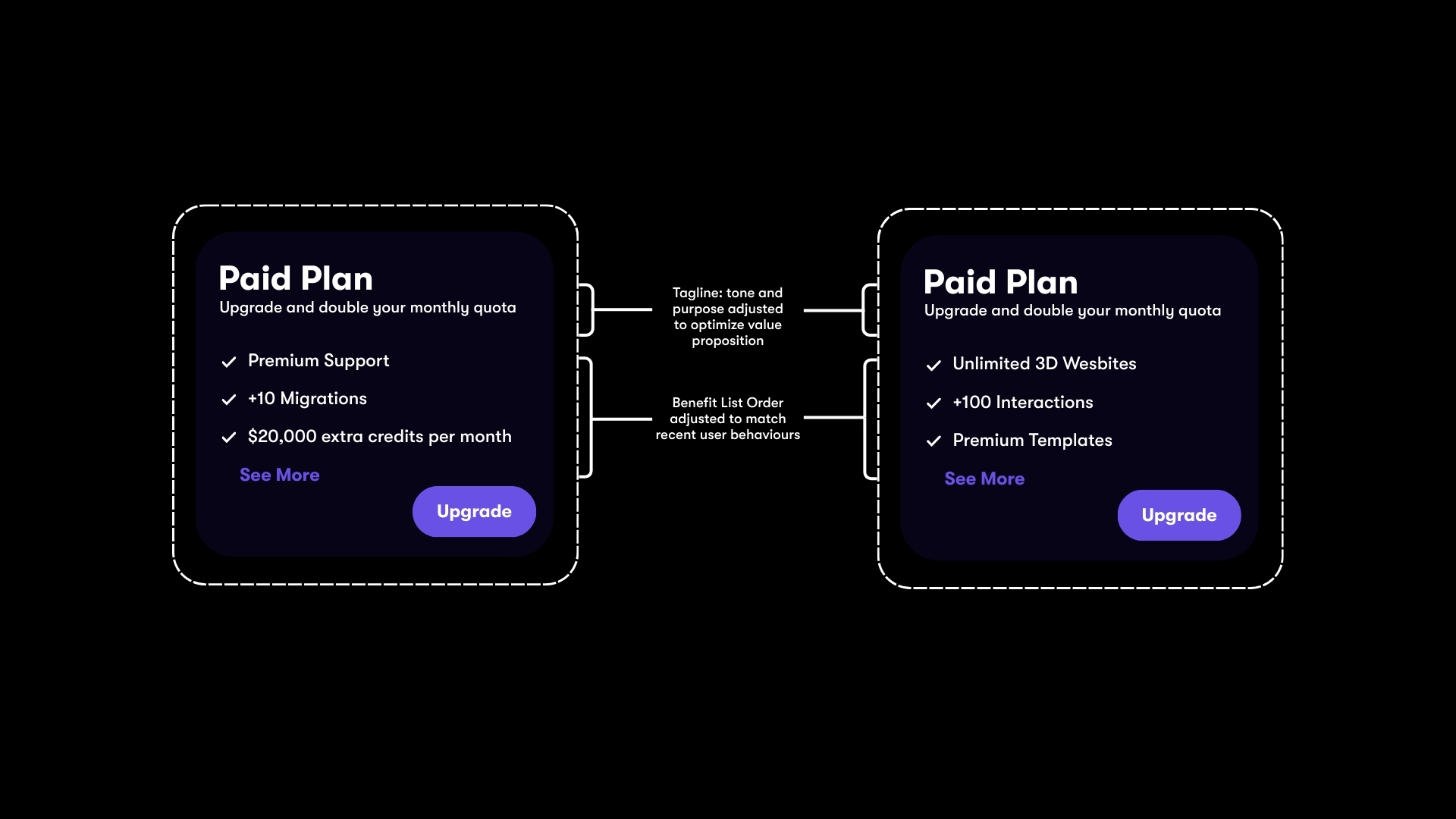As a web design and development agency, we’ve had our fair share of moments where clients ask, “But what about this type of user?” or “Can we make it feel more personal?” It’s always that back-and-forth between checking things off the list and actually creating something that feels just right.
We get it. Every stakeholder wants their own version of the same page. Each user persona expects a unique experience. And for the teams building it, that usually means long nights, complex logic, and timelines that keep slipping.
But the tech world never stays still. Right now, we’re standing at the edge of a major shift. Generative UI and hyper-personalization are introducing a new way of thinking about design, user experience, and how we build for the web.
What is Generative UI?
Imagine a world where every digital interface adapts to your needs in real-time, personalized, responsive, and context-aware. That is Generative UI, where Artificial Intelligence (AI) powers dynamic interfaces that evolve with your preferences and interactions. Unlike static, pre-designed layouts, Generative UI adjusts on the fly, creating personalized experiences tailored just for you. This revolutionary approach to design reshapes how interfaces are built, emphasizing adaptability and user context to make every interaction smarter and more relevant
With hyper-personalization now possible, dynamic interfaces are the next step in the journey toward adaptive UI. With generative UI, no two digital experiences will ever be the same.
How Generative UI Transforms User Experiences and Personalization with AI
Generative UI revolutionizes user interactions by offering real-time adaptability. Unlike traditional static interfaces, dynamic UI powered by generative AI responds immediately to user behavior, preferences, and even environmental factors.
Real-Time Adaptability
Generative UI enables real-time adaptability, ensuring that your product reacts instantly to user actions and external influences. This means that as soon as a user interacts with it, the interface adapts to match their needs. Whether it’s adjusting content based on browsing history, offering personalized navigation, or even changing layouts based on real-time data, Generative UI makes the user experience more fluid and responsive.

Hyper-Personalization
With AI at its core, Generative UI takes personalization to the next level by dynamically adjusting the content and design based on individual user data. This includes factors like browsing history, preferences, and past interactions. For instance, an e-commerce website might show tailored product recommendations or rearrange categories based on a user’s past purchases. This results in a more engaging experience, as each visitor feels the website is designed specifically for them, enhancing both satisfaction and conversions.

Boost Efficiency and Cut Costs with Dynamic Design
Generative UI saves both time and money by reducing the need for constant manual updates and adjustments to your application or website. Instead of spending hours tweaking designs or launching new versions, AI-driven systems automatically adapt and optimize based on user interaction data. This results in faster turnaround times for site improvements and allows businesses to focus resources on other strategic areas, such as customer acquisition or content creation. Over time, this leads to significant savings in both operational costs and development efforts.
Stay Ahead of Competitors
Adopting Generative UI early can provide businesses with ‘early movers advantage’. As more companies shift to dynamic and personalized web experiences, those who invest in cutting-edge technologies like Generative UI will differentiate themselves from competitors still using static designs. Offering an adaptive UI not only enhances user engagement but also strengthens brand reputation by positioning the business as an innovative leader in its industry.
Seamless Integration with Existing Systems
One of the biggest benefits of Generative UI is its ability to integrate seamlessly with existing website infrastructure. Whether you are working with an established CMS or a custom-built platform, Generative UI works alongside your current systems without requiring a complete redesign. This means businesses can enhance their product functionality and user experience without disrupting their existing operations, providing an efficient and low-risk upgrade path.
Scalability and Future-Proofing
As your business grows, so should your website. Generative UI allows for easy scaling, ensuring that as your user base expands, the site remains responsive, personalized, and efficient. The flexibility of dynamic UI ensures that future changes or additions can be integrated smoothly without overhauling the entire design. This scalability not only supports growth but also future-proofs the site, keeping it relevant and competitive for years to come.
Challenges of Implementing Generative UI: Navigating the Complexities
Generative UI offers immense potential for personalizing user experiences and driving engagement, but it does not come without its challenges. Below are the key hurdles that businesses must address when adopting this innovative approach to web design:
Overcoming Technical Complexity in Generative UI
Generative UI relies heavily on complex algorithms and real-time data processing. Building and maintaining such systems can be technically demanding, requiring expertise in AI, machine learning, and real-time data integration. The complexity increases when scaling up to accommodate large user bases, which means investing in high-quality infrastructure and advanced technical knowledge.
Balancing Personalization with Privacy Concerns
Personalization is at the heart of Generative UI, but this also brings up significant privacy concerns. Users’ personal data, such as browsing history and geolocation, plays a crucial role in delivering personalized experiences. However, businesses must navigate stringent data protection regulations (like GDPR) and ensure that users’ privacy is respected. Failing to do so could lead to trust issues and legal ramifications.
Managing Performance and Load Times
Generative UI’s dynamic nature can be resource-intensive. Real-time adaptability demands continuous data processing and content updates, which may impact performance, especially during high traffic periods. Slow load times or performance hiccups can frustrate users, leading to higher bounce rates and lower engagement. Optimizing performance without sacrificing the UI’s dynamic nature is a fine balance.
Ensuring Consistency Across Devices
As users access websites and applications on a variety of devices and screen sizes, maintaining a consistent and seamless experience across all touchpoints can be challenging. Generative UI must be adaptable not just to individual users, but also to different device capabilities. Ensuring that content, layout, and features look and perform well across desktops, tablets, and smartphones is crucial for a positive user experience.
Generative UI vs Traditional UI: A Comparison
Here’s a table that outlines the key differences between Generative UI and traditional UI approaches:
Feature
Generative UI
Traditional UI
Adaptability
Real-time adaptability based on user data and behavior.
Static, fixed templates with limited customization.
Personalization
Personalized user interfaces driven by AI, continuously evolving.
Generic interface delivering the same experience to all users.
Data-Driven Design
AI algorithms analyze user data to make real-time adjustments.
Design changes are manually implemented.
Flexibility
Highly flexible, dynamic content that adapts to each user.
Limited flexibility based on predefined templates.
User Experience
Seamless, intuitive, and highly contextual based on real-time inputs.
Rigid, often feels less responsive to user needs.
Development Complexity
More complex to implement due to AI and real-time adjustments.
Easier to implement, but lacks advanced features like real-time adaptability.
Content Management
Content is dynamically generated or updated based on user interaction.
Content management is static, requiring manual updates to change layouts.
Gen AI Use Cases
E-commerce Websites: Personalized Shopping Experience
Generative UI in e-commerce websites, dynamically adjusts layouts and content based on user behavior and preferences. For instance, a user who frequently browses electronics and only reads the headings may see personalized product recommendations that have optimized headings and better pictures. This personalization enhances the shopping experience and boosts conversion rates by making the site feel tailored to the individual, increasing user engagement and retention.

Smart Websites: The epitome of Hyper-personalization
Static, template-based websites are now a thing of the past. Today, smart websites powered by generative UI are leading the way. These websites adapt in real-time based on user engagement, creating a unique experience for every visitor. Rather than following a single, fixed flow, each user journey is personalized according to the user’s persona. Every section and piece of content is tailored and optimized for the individual, ‘building itself around the user’.

Personalized Messaging
As mentioned earlier, both text and data can be tailored to a user’s preferences and past interactions. But how does this benefit marketers and businesses? By personalizing messaging based on each customer’s journey and engagement. For instance, one customer may have tried a product for just a few months, while another may have already committed to using it for a full year. By showing each lead tailored packages suited to their specific needs, businesses can reduce friction and help users make quicker, more informed decisions.

The Future of Generative UI: Atompoints Role In It
The future of Generative UI is undoubtedly exciting, with continuous advancements in AI making it increasingly sophisticated and capable of delivering deeply personalized experiences. As AI models become better at understanding user behavior and preferences, dynamic UI will become even more personalized and intuitive.
In the near future, we can expect Generative UI to integrate more advanced features, such as predictive text, voice interaction, and even immersive AR/VR interfaces. By using natural language processing and machine learning, AI will not only generate dynamic UI but will also anticipate user needs, delivering experiences that feel both intuitive and proactive.
As AI continues to drive Generative UI, we’re likely to see UIs that can respond to the user’s emotional state, preferences, and context taking personalization to a whole new level.
Development at Atompoint
At Atompoint, we’ve been creating 3D websites for a while, but now, the geniuses behind the scenes are taking things to the next level. We’re on the brink of developing websites fully integrated with artificial intelligence. These websites will be self-aware, adapting to user engagement and delivering personalized experiences. Our developers have already built an open-source smart agent for teachers and students to enhance learning. Now, it’s time to create something that can help everyone.
Conclusion
The future of web design is rapidly evolving, and dynamic websites powered by generative UI are leading the way. As technology continues to advance, we’ll see a shift where every website becomes smarter, more adaptable, and deeply personalized to the user’s preferences. Just like mobile apps today, websites of the future will have the ability to continuously evolve, creating an engaging experience that is unique for each visitor.
The ability to provide real-time adaptability, hyper-personalization, and seamless user experiences will be the key differentiators for businesses that succeed in the competitive digital space. The best time to embrace this transformation is now, before it becomes the standard for every website. As businesses and brands continue to evolve, those who invest in generative UI and dynamic experiences today will not only stand out but lead the charge toward a smarter, more interactive web.

